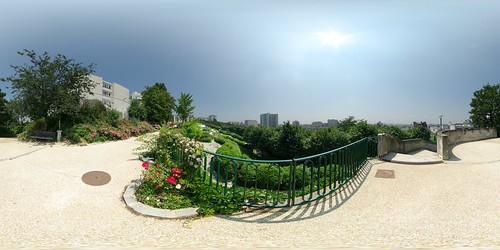
Parc de Belleville
Belleville is a neighborhood in the northeastern part of Paris. Perched on the city’s second highest hill, Belleville was originally a city of its own. In 1860, it was annexed by Paris. The neighborhood has historically been working class, home to alternative artists and musicians, and the breeding ground of leftist and communist sentiments. In many ways, it was Belleville that was the cog behind the Paris Commune uprisings in 1871; its streets the scene of some of the bloodiest fighting in that dreary May. Today, Belleville has become a very multicultural neighborhood, inhabited by Jews, Chinese, Greeks, Spaniards, Armenians, Algerians and other North Africans. The neighborhood has become especially attractive to Parisian artists and musicians who live and work in the quarter’s studios as well as the art squats that have been transformed from old abandoned factories.[1]
The main attraction of Belleville is its charming, narrow streets, a reminder of Old Paris especially at Place des Fêtes where much of the medieval architecture remains preserved. Parisians enjoy coming to Belleville during the week on Tuesdays and Fridays for the outdoor farmers market held along the quarter’s streets at Boulevard de Belleville.
The quarter also has lovely parks such as the Parc des Buttes Chaumont and the Parc de Belleville, whose sloping hills provide panoramas of the Paris skyline. In contrast to the look and feel of Parc de Belleville, the Parc des Buttes is very different with its classical gardens and 19th century romantic feel.[2]
Belleville is also home to the Église Réformée de Belleville, a century-old church, and one of the city’s two Chinatowns on Rue Rebelvalle. The Chinese community there only recently developed in the last thirty years.[3]
Attractions
Place des Fêtes
Farmers Market at Boulevard de Belleville
Chinatown on Rue Rebelvalle
Parc de Belleville
Parc des Buttes
References:
“Belleville, Paris.” <http://en.wikipedia.org/wiki/Belleville%2C_Paris>
[1] Belleville
[2] Id.
[3] Id.


Comments